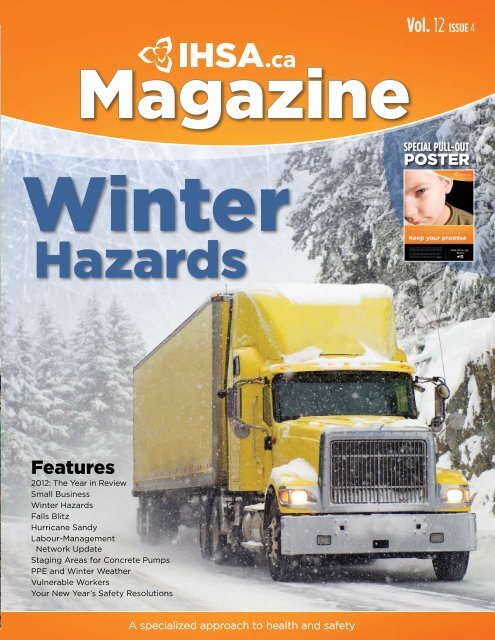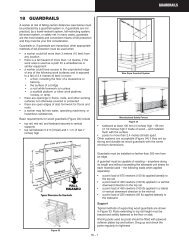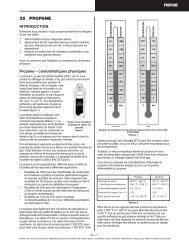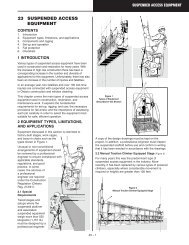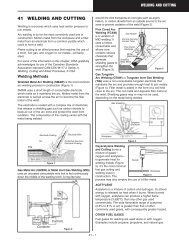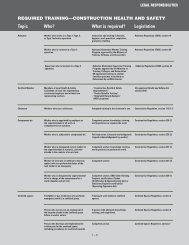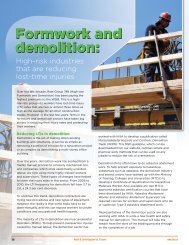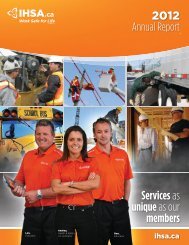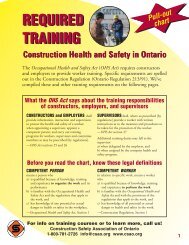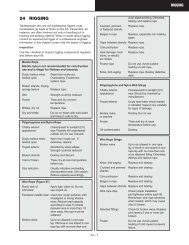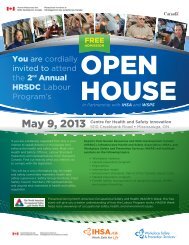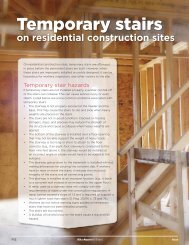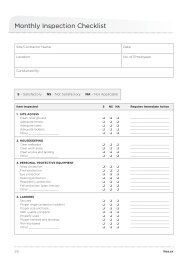downloadable - Infrastructure Health & Safety Association
downloadable - Infrastructure Health & Safety Association
downloadable - Infrastructure Health & Safety Association
- No tags were found...
Create successful ePaper yourself
Turn your PDF publications into a flip-book with our unique Google optimized e-Paper software.
Returning home safe to your lovedones is a promise you make everyday.Keep your promise.Tragically in Ontario a worker dies almost every day from eithera workplace injury or illness. They will not be able to keep thepromise they made to friends and family to come home safely.In every workplace, hazards need to be respected, controlled,and if possible, eliminated. Getting home safely each day requiresrespect for the hazards that can occur, no matter how remote thepossibility. Learn how IHSA can help. Visit ihsa.caihsa.ca
CEO message2012: The year in reviewAs we come to the end of another year as the<strong>Infrastructure</strong> <strong>Health</strong> and <strong>Safety</strong> <strong>Association</strong>, I lookback with pride on our achievements so far. Our longand storied history of providing high-quality health andsafety education to Ontario’s workers began in 1914when the Workmen’s Compensation Act was passed,creating the Workmen’s Compensation Board andpermitting the establishment by employers of sectorspecificsafety associations. In 1915, the Electrical &Utilities <strong>Safety</strong> <strong>Association</strong>—one of IHSA’s legacyorganizations—was given the mandate to deliver safetyeducation in a sector that was struggling with a 50 percent mortality rate.The Construction <strong>Safety</strong> <strong>Association</strong> of Ontario wasformed in 1929 and the Transportation <strong>Health</strong> and<strong>Safety</strong> <strong>Association</strong> in 1942 to offer safety educationin other high-risk sectors. So, prevention is not newfor us—we have been providing high-quality sectorspecifichealth and safety education for a combined250 years. It’s our history, but it’s also the foundationwe continue to build upon for the future.While our first year as IHSAwas focused on uniting ourassociations and establishingour new identity, our secondyear was about taking stepstowards what we wantedto achieve in the future. In2011, we developed a threeyearstrategic plan that isdependent upon IHSA’s abilityto create unique value. In2012, we focused on putting this strategicplan into action.With the experience and expertise of our threelegacy associations, we have built a one-of-a-kindorganization that delivers high-risk-activity programsand materials to our members. No one else in Ontario’sprevention system offers the quality and scope oftraining that we do. We provide 85 unique trainingprograms, and we continue to provide 22 programsand 44 products at no charge to members. Thanks4IHSA.ca Magazine Vol. 12 Issue 4ihsa.ca
to our service-delivery model and our highly skilledteam of regional trainers and consultants, we have theunique ability to offer all our educational programs ondemand, anywhere in Ontario.IHSA’s commitment to quality is unmatched, andour philosophy of safety education through skillsdevelopment will continue to make Ontario workersthe safest in the world. Yet there is always moreto be done. I have spent the past year travellingthroughout the province and introducing our strategicplan to stakeholders. One question I am often askedis, after 97 years of facilitating the safety educationmandate in Ontario, what is needed to make furtherimprovements?In my opinion, the answer is mandatory trainingstandards. We desperately need a governing body todevelop standards, establish curricula, and authorizetraining-delivery agents in order to facilitate effectivetraining methodologies, including evaluation programsfor high-risk activities. To that end, we have beenworking actively with the Chief Prevention Officer(CPO) to develop training standards and a health andsafety strategy for Ontario.Each new year brings new accomplishments andnew challenges, and I am enthusiastic about theopportunities that nowlie ahead of us. Wecontinue to expandstakeholder engagementthrough our network ofLabour-ManagementCommittees, AdvisoryCouncils, and Fleet<strong>Safety</strong> Councils. Weare collaborating withstakeholders and otheragencies to expand ourcapacity and reach outto new markets. Ournew Centre for Educational Excellence initiative willensure the quality of our deliverables by improvingthe excellence of our instructors and by embeddingevaluation and ROI methodologies into our high-risktraining programs. We will continue to take advantage ofnew technologies and training-delivery formats to reachsmall businesses and vulnerable workers. Many thingsmay change, but our goal will always stay the same—thecontinued health and safety of Ontario workers.Al Beattie, President and CEOihsa.caIHSA.ca Magazine Vol. 12 Issue 45
Small businesshealth and safety managementSmall businesses are the economic foundation of Ontario. That was true in thepast and continues to be true today. Last year, businesses with fewer than 50employees made up 95 per cent of all businesses in Ontario accordingto the Ministry of Economic Development and Innovation. Small andmedium-sized firms employed 2.8 million people in Ontario.IHSA recognizes that the health and safety needs of small businessesare different from those of large firms. As with any other aspect ofrunning a business, managing a health and safety program for fouremployees can be very different from managing a program forfour hundred. That’s why ihsa.ca has a Small Business sectionwith tools and resources designed to help small-businessowners and managers navigate Ontario’s health and safetysystem. Here are some of the things you’ll find there.Online certificate programsIHSA recently added two new online certificate programsspecifically for independent operators and small businesses. Thesetwo programs provide the basic health and safety informationworkers and employers need to get the job done safely. The flexibilitygained from completing the courses entirely online is ideal forindependent operators and small businesses. Once you’ve completedall the courses, IHSA will issue you a <strong>Health</strong> and <strong>Safety</strong> Certificate.Independent Operator CertificateThis certificate requires the completion ofthree e-learning courses:• Bill 168 – Achieving Compliance• Workplace Hazards: Identification,Assessment and Control• PPE (Awareness).Small Business CertificateThis certificate requires the completionof five e-learning courses:• Bill 168 – Achieving Compliance• Workplace Hazards: Identification,Assessment and Control• PPE (Awareness)• Incident Investigation• Workplace Inspections.Visit the Small Business section at ihsa.ca for details.6IHSA.ca Magazine Vol. 12 Issue 4ihsa.ca
Stay safe while driving by observing the followingprecautions:• Inspect your vehicle to confirm that everything is ingood working order, including wipers and washersolution, heaters and defrosters, lights, battery, andradiator antifreeze.• Make sure your vehicle has suitable tires thatprovide good traction.• Start off slowly and keep driving slowly ifconditions are poor.• Remember that you need 3 to 12 times as muchdistance to stop on ice and snow as on a dryroad (and the heavier the vehicle, the greater thestopping distance).• Remember too that as the temperature rises, icebecomes more slippery because the top layerbegins to melt.• Keep a safe distance behind the vehicle in front ofyou in case you need to stop suddenly.• Clear all the snow and ice off your windows,mirrors, and lights.• Watch out for black ice. (The normal colour ofasphalt in cold weather is greyish white. If it’s shinyand black, it could be ice.)Carbon monoxideWith temperatures dipping well below freezing, manyworkers try to keep themselves warm with gasoline-,propane-, or diesel-fuelled heaters. They often keepwarehouse and garage doors closed to keep the coldout, which also keeps exhaust in. While staying warmmay prevent frostbite and hypothermia, the carbonmonoxide in the exhaust from heaters, vehicles, andother fuel-burning equipment can be deadly. Carbonmonoxide (CO) is a colourless, odourless, and tastelessgas that can poison you. The first signs of poisoningare fatigue and headache, which can be followed byunconsciousness and heart failure.When using heaters and other fuel-burning equipment(including vehicles) in an enclosed space, take theseprecautions:• Whenever possible, use electric heaters or heatersthat vent byproducts outdoors to eliminate the riskof CO poisoning.• Make sure the area is well ventilated by keeping thedoors and windows open.• Check CO levels regularly with a gas detector.• If possible, use exhaust hoses or fans to draw theexhaust out of the work area.• Make sure heaters and other fuel-burningequipment are in good condition.Visit ihsa.ca for more information on these topics, andif you are an employer, go over them with your staff.ihsa.ca IHSA.ca Magazine Vol. 12 Issue 49
Falls blitzcoming in FebruaryGet ready for February—which is Fall Preventionmonth—and for the Ministry of Labour’s (MOL’s)enforcement blitz on slips, trips, and falls.Unfortunately, falls are still one of the leading causesof fatalities and critical injuries across Ontario. In theindustries served by the <strong>Infrastructure</strong> <strong>Health</strong> and<strong>Safety</strong> <strong>Association</strong> (IHSA), the number of lost-timeinjuries caused by falls in 2011 rose by 3.2 per cent fromthe previous year. Those statistics show that we needto do more to reduce falls in our industries.Start the year off right by preparing for MOL’s blitz onslips, trips, and falls. Throughout February and March,MOL inspectors will pay particular attention to slip,trip, and fall hazards when they visit workplaces.They will also be looking for evidence thateveryone in the workplace knows his or herresponsibilities for fall prevention underthe Occupational <strong>Health</strong> and <strong>Safety</strong>Act and related regulations.More specifically, inspectors will focus on• the duties of employer, supervisor, and workersunder the Occupational <strong>Health</strong> and <strong>Safety</strong> Act andcompliance with the requirements for fall protectioncontained in the regulations• hazard recognition and controls, fall prevention bestpractices, adequate measures and procedures, andemergency planning• safe use of ladders, including portable ladders,manufactured ladders, job-built ladders, andvertical ladders• education and training of workersMake sure all your workers have received fallprevention training. If you’re in the constructionbusiness, that’s mandatory. Visit ihsa.ca for detailson IHSA’s Working at Heights training program. Hereare some other tips to help you and your workers getready for the blitz.Preventing falls from heights• Guardrails and floor opening covers should beyour first choice when it comes to preventing falls.They offer the best protection because they actuallyeliminate the fall hazard if they’re set up properly.With guardrails in place, you can’t fall becausethere is no open edge. With secured floor openingcovers in place, you can’t fall because they eliminatethe opening.10IHSA.ca Magazine Vol. 12 Issue 4ihsa.ca
• From time to time, you may have to remove one or moreguardrails to allow a delivery or access to certain equipment.Remember that before a guardrail is removed, everyone workingin the fall hazard area must be protected by another form of fallprotection (such as a travel restraint or fall-arrest system). Assoon as it’s possible, put the guardrails back.• When it’s not possible to use guardrails, use a travel restraint orfall-arrest system and ALWAYS tie off to a suitable anchor point.• Avoid working from ladders. Use a work platform wheneverpossible.• Always maintain three-point contact when you’re going up ordown ladders and when you’re climbing on or off vehicles orequipment.Preventing slips and trips• The best way to prevent slips and trips is to practice goodhousekeeping. Keep pathways and work areas clear of materialsand debris.• With snow and ice during the winter months, you need to takeextra care to prevent slips and trips. Keep walkways, access areas,and stairs clear of snow and ice. Use salt or sand in those areasand ensure your boots provide good traction.• Stack materials neatly and secure them so that they can’t fall intopathways or work areas. Make sure the surface they are on cansupport their weight.• Make sure that cords from power tools and lights don’t pose atripping hazard. Fasten the cords to the floor or keep them awayfrom pathways and work areas. Unplug them when they aren’tin use.Visit ihsa.ca and follow this link:http://www.ihsa.ca/topics_hazards/fall_prevention_wah.cfm.You will find posters, safety talks, and other resources to help youprepare for the blitz on slips, trips, and falls.Greatproductsavailable at ihsa.caGet ready for the MOL’senforcement blitz on slips,trips, and falls with these greatproducts. Use posters, stickers,and DVDs to help make sure allyour workers are prepared.Fall ProtectionPoster (P042)17" x 22" VinylM: $6.45NM: $13.95Fall ProtectionDVD (FD046)M: $24.95NM: $199.95Slips and Falls<strong>Safety</strong> MeetingPackage (SMP018)M: $64.95NM: $129.95Fall Protectionstickers (S052)2½" 10/pkgM: $0NM: $5.95Use Your Harnesssticker (S042)3" x 2" 50/pkgM $34.95NM: $74.95Find it all online!To order products,visit ihsa.caihsa.caIHSA.ca Magazine Vol. 12 Issue 411
Ontario utilitieshelp restore power in USafter Hurricane SandyWhen our neighbours to the southneeded assistance to rebuild theirdamaged electrical grid in the wakeof Hurricane Sandy, Ontario’s utilitiesand utility contractors answeredthe call.According to the ElectricityDistributors <strong>Association</strong>, about 400electricity distribution workers from25 Ontario utilities have travelledto Long Island, New York and otherNortheastern states to restorepower to communities devastatedby Hurricane Sandy. As well, utilitycontractors joined in sending workersfrom across the province.Once their own Ontario customers’power had been restored, crewstravelled across the border to helpthe millions of customers that werewithout power while those utilitiesfaced the enormous task of repairingthe devastated electricity grid.Workers returned home safely andhave provided IHSA with photos ofwhat they saw during their efforts.Special thanks to those utilitiesand contractors whoprovided photos. There aremore to see on our websiteat ihsa.caHorizon staff had to work in jungle-like conditiorestore power on Long Island.PowerTel’s convoy travelled to Rutland, VermonEntegrus crews spent most of their time in West Amwell and Lambertville,NJ—and were made Honourary Citizens of Lambertville.Horizon faced tough restoration conditions such as road damage.Oakville Hydro was busy with many repairs.
tns toGridlink employees worked long days for three weeks inVermont and New York. Employees included CambrianCollege Powerline Technician student Tegan Denley, seenhere in Bedford, New York. She’s now back at school.London Hydro worked on backyard repairs in Long Island.London Hydro workers take part in construction inSayville, New York.Oakville Hydro workers took to the streets of Hempstead,New York, to help repair the damage done by thehurricane and subsequent “nor’easter.”PowerStream workers got some help themselves fromthis little assistant who handed out bottles of water.PowerTel trucks prepare to cross the border at HighgateSprings, Vermont, just south of Montreal. Thiswas 7 am Monday, October 29, 2012.
Labour-ManagementNetwork UpdateThe Labour-Management Network of <strong>Health</strong> and<strong>Safety</strong> Committees is one of the principal reasonswhy Ontario is the safest place in North Americafor workers. The Network—which is the only one ofits kind in North America—consists of the ProvincialLabour-Management <strong>Health</strong> and <strong>Safety</strong> Committeefor construction, as well as 16 Regional and 24 Trade/Sector Labour-Management committees. These groupsrepresent hundreds of thousands of constructionworkers, trade unions, and construction employers.Here we feature some of the latest news andinformation from the network.Supervisor seminar a popular eventA one-day session on supervisory training andcommunications best practices was held on September6 at IHSA’s newly renovated training facility at 21Voyager Court in Etobicoke.IHSA’s Labour-Management Network arranged thiscomprehensive session to tie in with a Ministry ofLabour (MOL) blitz of construction sites in which theywere investigating supervisors’ credentials or generalawareness of health and safety hazards.The keynote speaker, Wayne D, L’Orme (picturedabove), who is Assistant Director of the Occupational<strong>Health</strong> and <strong>Safety</strong> Branch at the Ministry of Labour,talked about the MOL blitz and provided importantdetails about what to expect from MOL inspectorswhen they come calling during the blitz.After the keynote address, the participants couldchoose to attend any one of four smaller sessions:• John Kelly presented a session for supervisors onthe use of log books, due diligence, and safety talks.• Robbie Shaw gave a presentation on resources andresearch techniques, including auditing principles, theCertificate of Recognition (COR TM ), and site inspections.• Lou Terpstra gave a session on inspections andrunning effective meetings.• Doug Heintz hosted a presentation on effectivecommunications, the use of personal influence, andadult education.While the participants were enjoying lunch, they had anopportunity to network and visit with representativesof the MOL, the Workplace <strong>Safety</strong> and Insurance Board(WSIB), the Ministry of Transportation (MTO), theElectrical <strong>Safety</strong> Authority (ESA), and the College ofTrades, all of whom were on hand to provide informationon their organizations and answer questions.During a panel discussion, guests from the MTO, MOL,WSIB, IHSA, and ESA gave a brief overview of whattheir respective organizations do and how they interactwith supervisors. Then the floor was opened to theaudience for questions about a number of workplacesituations.14IHSA.ca Magazine Vol. 12 Issue 4ihsa.ca
Would this kind of session be of interestto your community or sector?Due to the success of the communications seminar,some regional and trade committees may considerrunning another session. Watch for more information inthe future.Other projectsThe Labour-Management Network is always busy withnew projects and ideas. Here are just a few that thevarious committees have been working on:• All Labour-Management Committee co-chairsmet on September 5 to discuss topics of commoninterest and share information. The meeting washeld at IHSA’s revamped Voyager Court trainingfacility. Visitors were able to see the new classroomsand hands-on training facilities during the event.• The inaugural issue of a new publication calledNetwork e-News has been introduced and sentto all members of the network. This is based on anewsletter that used to be published by the formerConstruction <strong>Safety</strong> <strong>Association</strong> of Ontario; it wasbrought back due to popular demand. It is e-mailedto all members of the network.• Occupational health risks brochures for a number oftrades have been completed and are posted on theIHSA website under Products.• The Pipe Trades Committee investigated thebenefits of pre-job stretching exercises at thejobsite. The committee decided that IHSA’s BeforeYou Start Work Exercises Card (VO12) was a goodtool for use in a worksite program on pre-jobstretching exercises.• The Mechanical Advisory Council has endorsedIHSA’s recently completed Supervisor Log Book(RF008).That is just a sample of the many activities taking placein the network. The committees strive to keep abreastof new issues and work with IHSA to come up withstrategies to reduce hazards in the various industriesIHSA represents.If you would like to learn more about the IHSALabour-Management Network of <strong>Health</strong> and <strong>Safety</strong>Committees, please contact George Iacono at IHSA.The committees strive to keepabreast of new issues and workwith IHSA to come up withstrategies to reduce hazards.ihsa.caIHSA.ca Magazine Vol. 12 Issue 415
Staging areasfor concrete pumpsand boom trucksConcrete pumps and hoisting devices such as boom trucksare a common sight on most residential construction sites.But if these large machines are not set up properly, theresult can be serious and even deadly. Recent incidentsinvolving concrete pumps led to the formation of anIHSA sub-committee to study the problem and makerecommendations to the homebuilding industry.One solution was to plan the jobsite properly andcreate staging areas for concrete pumps andboom trucks. A staging area is a designatedplace to set up vehicles, supplies, andconstruction equipment for convenientuse. Although there are no standards forstaging areas, here are some things toconsider when setting up concretepumps and boom trucks.Access to jobsiteManoeuvring large equipmentlike concrete pumps and boomtrucks through tight spaceson a busy jobsite can bedangerous.It also wastes valuable time.With proper planning, thejobsite can be more accessibleand equipment can be put intoplace quickly and safely.Space for setupIf concrete pumps and boom trucks haveenough space to set up, they can properlydeploy their outriggers, which prevent themfrom tipping over and causing injuries or death.If boom trucks have enough setup space, theywill be able to get close enough to the work areato offload safely. When workers have to move thematerial manually, it increases their risk of developing amusculoskeletal injury.Access for emergency vehiclesWhen planning a staging area, make sure to leave enoughroom for emergency vehicles to get through. If an injury happens,you want emergency services to get to the injured person as quicklyas possible.According to the Regulations for Construction Projects, the constructoris legally required to have emergency procedures in place and to provideaccess for emergency vehicleson a jobsite.16IHSA.ca Magazine Vol. 12 Issue 4ihsa.ca
Regulations for Construction Projects17. (1) A constructor shall establish for a projectwritten procedures to be followed in the event of anemergency and shall ensure that the procedures arefollowed at the project. O. Reg. 213/91.Staging areas71. Adequate means of egress shall be provided from awork area to permit the evacuation of workers duringan emergency. O. Reg. 213/91.HousekeepingKeeping the jobsite clean and well organized helpsensure that concrete pumps and boom trucks haveenough space to move around and set up.Soil stability and compactionOutriggers must be set on soil that is sufficiently stableand compact to support the weight of the machine.Spoil or excavated material is soft and loose, so avoidpiling it near the setup area. Spoil piles can alsoblock the pumping or offloading areas and preventoutriggers from being fully deployed.Overhead powerlinesContact with overhead powerlines is a common hazardfor concrete pumps and boom trucks. But if the jobsiteis planned properly and staging areas are set up,operations that occur near overhead powerlines can bereduced or eliminated.Underground utilitiesDon’t forget about hidden hazards such as catchbasins, electrical vaults, and utility trenches. They canbreak if outriggers are set on top of them, and themachine may tip over.Jobsite planningHaving large equipment on a jobsite can be disruptive.Constant adjustments have to be made to accommodatethis equipment (e.g., having to double-handle spoil andother materials). If workers fall behind schedule and haveto rush, there is a greater chance of accidents. A wellplannedjobsite can prevent these problems.Benefits of a well-planned jobsite• The jobsite is safer for all trades.• The general public is safer.• The jobsite is more efficient, meaning that morefoundations will be poured and setup time willdecrease. And with fewer setups there is lesschance of accidents.• Costs are lower because delays are minimized.• Workplace parties will receive fewer MOL orders.The best time to select the staging areas for concretepumps and hoisting devices such as boom trucks isduring the development phase of the project. Here aresome best practices when setting up staging areas.• Designate and mark specific driveways or otherareas for setup. Once the concrete pumps andboom trucks are done, these staging areas canbe used as delivery areas and temporary laydownareas for other trades.• Identify overhead powerlines and the location ofunderground utilities so you can avoid them asmuch as possible.• Set up temporary powerlines behind excavations oraway from staging areas.• Compact the soil around the staging area or coverit with stone so it will support the pressure ofoutriggers.• Designate areas for excavated material or spoil soit won’t compromise the soil conditions around thestaging area or affect the setup and operation ofthe equipment.• Designate areas where concrete pumps and boomtrucks can be cleaned out.• Predetermine the size of the machines you’ll beusing so you’ll know how much space you need.Proper jobsite planning, which includes setting upstaging areas for concrete pumps and boom trucks,can prevent most—if not all—of the hazards causedby large machines and equipment. People often thinkplanning takes more work, but putting together aneffective course of action can help simplify a lot oftasks, save time, and improve safety.For more info, visit the Heavy Equipment topic pageon our website or download our “Safe Setup of HeavyEquipment” safety talk.ihsa.caIHSA.ca Magazine Vol. 12 Issue 417
Personal protectEveryone knows that personal protective equipment(PPE) is designed to protect them against threatsto their safety or health in the workplace. But youmay not realize that those threats can include coldtemperatures and other kinds of severe weather.As the temperature falls, workers who spend much oftheir time outdoors should be sure they are preparedfor the cold. At the same time, they should still be ableto use all of the PPE that’s required both by the lawand by their employers. If you are an employer, you alsoneed to think about eliminating the hazards of coldweather if at all possible.It’s important to choose protective clothing that issuitable for the temperature, the work you will bedoing, and the physical exertion that is required by thetask. A person doing a physically demanding job mayneed different clothing than a person doing a moresedentary task.Cold-weather tipsWarm clothing can help prevent a number of coldweatherhazards, such as frostbite and hypothermia.(For more about these hazards, please read “ProtectYourself from Winter Hazards” on page 8.) Coldtemperatures can also reduce your mental alertnessand manual dexterity, and that can lead to dangeroussituations. The following tips can help you choose theright kind of clothing for cold weather:• Wear several layers of clothing rather than one thicklayer. The air that’s captured between the layers isan insulator.• If the job allows it, wear synthetic fabrics, such aspolypropylene, next to the skin because they wickthe sweat away.• Don’t have your clothing so tight that it restrictsyour movements.• If the weather is wet as well as cold, be sure your outerclothing is waterproof, or at least water-repellent.• Wind-resistant fabrics may also be necessary undersome conditions.• At air temperatures of 3°C (37.4°F) or less, workerswhose clothing gets wet for any reason mustimmediately be given a change of clothing andtreated for hypothermia.• Encourage the use of hats and hoods to preventheat loss from the head and to protect the ears.• Balaclavas or other face covers may also benecessary under certain conditions.• Tight-fitting footwear restricts the blood flow.Footwear should be large enough to allow for eitherone thick pair of socks or two thin pairs. Wearingtoo many socks can tighten the fit of footwear andharm rather than help.• If you get hot while you’re working, open yourjacket but keep your hat and gloves on.• When you put on extra layers of clothing forwarmth, make sure none of it will pose a hazard,such as by catching on machinery.18IHSA.ca Magazine Vol. 12 Issue 4ihsa.ca
ive equipmentand winter weatherThose tips will help keep you warm. But at the sametime your winter clothing must be safe. The followingsections point out some special safety considerationsabout particular pieces of PPE and the kind of workyou’re doing.Hard hatsThough it’s important tokeep your head warm, youalso have to be sure yourhard hat is still protectingyou. If you’re wearing a hator hood under the hard hat,make sure it won’t allow yourhard hard hat to slide off. Some hoods or “hoodies”can also block your view to the side. It may be safer towear a winter hard hat liner.Arc flash hazardsIf you are working on or near energized equipment,it’s important not only to keep warm but also to makesure your clothing is rated for protection against arcflash hazards. Synthetic materials that can melt shouldnot be worn by workers who are exposed to certainelectrical hazards.PPE, as well as inner layers of clothing, should be madeof an appropriate material, such as a natural fibre oran Arc/FR-rated material suitable for the type of workbeing done.You should be aware that some undergarments orinner layers of clothing can be unsafe even if yourouter layer of clothing is made of an approved material.For example, if a hoodie or turtle neck shirt that you’rewearing under your winter jacket is made of non-Arc/FR-rated materials, it can melt in an arc flash incidentand cause severe burns.If you are required to wear rubber protective gloves, asutility workers are for example, your glove liners shouldalso be made of a suitable material such as Merino wool.FootwearWhen you arechoosing protectiveboots, you shouldalso be sure theyare warmand willstay dry.It’s important to chooseprotective clothing that issuitable for the temperature,the work you will be doing,and the physical exertionthat is required by the task.What the law saysabout PPESince the precise legal requirements for PPE arenot the same for every situation or every trade, itis necessary to consult the relevant sections of theOccupational <strong>Health</strong> and <strong>Safety</strong> Act or the Regulationfor Construction Projects (O. Reg. 213/91). Federallyregulated firms should refer to the Canada LabourCode, Part II.ihsa.ca IHSA.ca Magazine Vol. 12 Issue 419
VulnerableWorkersand the language of safetyOntario’s construction and transportation sectors are inever greater need of new workers to meet the demandfor skilled tradespeople and labourers. However, whenthese new workers are from non-English-speakingbackgrounds, the language of health and safetybecomes difficult.If those workers have not understood their trainingor their supervisors’ safety instructions because of alanguage barrier, they may be in danger on the job.Even workers whose first or only language is Englishmay still need help if their literacy skills are low.Ontario’s skilled trades are facing serious shortages, andthe provincial government is putting more emphasis onimmigration to fill these needs. For the first time, theMinistry of Citizenship and Immigration is emphasizingthe essential place of skilled immigrants in Ontario’sconstruction trades. The Ministry points to these facts:• Newcomers make up 30 per cent of Ontario’s labourforce.• Without continued immigration, Ontario’s workingagepopulation will begin to decline by 2014.In July 2012, the Ontario Council of Agencies ServingImmigrants reported that the second-highest concernamong immigrants was not having a thoroughknowledge of English; about 33 per cent of newcomerssaid it was a barrier to their integration into Canadiansociety. Their top concern was to find a job. That maybe why some of these workers are not willing to telltheir employers that they don’t understand safetydirections.Employers should consider the language spoken on theworksite and how best to speak to workers in a waythey will understand. It may be helpful to demonstratesafety hazards with images or pictograms and withgestures and hand signals.Who are vulnerable workers?Generally speaking, vulnerable workers are thosewho have recently moved to Ontario from anotherprovince or country, have just started their first job, orare returning to the workforce after a long absence.Vulnerable workers also include people who work inthe “underground” economy, especially those who20IHSA.ca Magazine Vol. 12 Issue 4ihsa.ca
do not have documentation—such as a SIN card orcitizenship papers—and refugees whose English isinadequate. Though they may be skilled at their work,the language barrier may result in more injuries in theworkplace.Vulnerable workers may be more exposed to injuryand illness than other workers because of their lack ofexperience, reluctance to ask questions, difficulty withEnglish, and the type of work they do.In a September 2008 report, the Conference Board ofCanada argued that there is an opportunity to increaseboth productivity and safety by improving literacy inthe workplace. The report described a two-year studywhich found that• workers with a lower literacy level may notunderstand all their health and safety rights andresponsibilities• workers who work in high-hazard areas or performhigh-risk tasks may not fully understand the healthand safety precautions required or the warningsgiven by their supervisors or employers.General tipsThere are a few things a company can do when it hasvulnerable workers among its employees.• Establish procedures and measures for workplacehealth and safety and make sure they are alwaysfollowed.• Be sure the proper equipment and personalprotective equipment are provided and aremaintained properly.• Insist that all hazards, illnesses, and injuries bereported immediately.• Provide proper and ongoing general training.• Point out hazards in the workplace and providetraining or instructions on how to handle them.• Respond promptly to all health and safety concernsexpressed by workers.• Lead by example: Use and wear safety equipmentwhen it is required and take part in drills and otheremergency-response training.Though they may be skilled at theirwork, the language barrier may resultin more injuries in the workplace.ihsa.caIHSA.ca Magazine Vol. 12 Issue 421
Your New Year’ssafety resolutions“If you cannot measure it, you cannot improve it.” — Lord KelvinA new year brings new beginningsand time to reflect. What did we accomplishlast year, and what do we want to accomplish in theyear ahead? It is the perfect opportunity to review theactivities of the previous year and use that informationto set health and safety targets and objectives for theupcoming year.As Lord Kelvin once said, “if you cannot measure it,you cannot improve it.” That’s why modern health andsafety practice uses performance measures. Withoutclearly defined performance measures, it is difficult toshow that your health and safety system is working.The measures provide quantifiable information aboutyour progress towards a goal and help to identifytrends. When monitored regularly they also let youdetect quickly when something is heading off track.When deciding what measures to use, you shouldconsider the areas that are most important to yourhealth and safety performance and then commit totracking and reviewing these measures. Performancemeasures should be• chosen objectively• reliably measurable• broadly applicable.All measures should be broken down into simple andunderstandable terms so they can be explained easilyto all staff. Measures should also include both leadingand lagging indicators.Leading and lagging indicatorsLeading indicators are conditions and activities thatprecede and affect the occurrence of workplaceinjuries and illness. They can uncover weak areasbefore something serious happens. Leading indicatorsshould be a mix of both qualitative and quantitativedata. Some examples of leading indicators are hazardand near-miss reporting, workplace inspections, sitevisits, training hours, and audit findings.Lagging indicators measure the safety of a workplacein hindsight. They are helpful for learning from whathas already happened, but they are not clues tosomething that may be unsafe now. Some examples oflagging indicators are number of medical-aid incidents,number of lost-time and non-lost-time injuries, andfrequency rates of lost-time injuries.All the measures should be consistent with theorganization’s health and safety policy and shouldbe based on reviews of the health and safety system.Each measure should be clearly defined, and theresponsibility for tracking it should be assigned to anindividual or group.There should be a schedule for regular reviews ofeach measure to ensure that they continue to reflectthe desired improvements in health and safetyperformance. It is also important that the data begathered the same way and from the same sourceevery time it is being reviewed.22IHSA.ca Magazine Vol. 12 Issue 4ihsa.ca
Safe Driving forConstructionThe hum of engines is constant on construction sites.From dump trucks to delivery trucks, various types ofvehicles are constantly moving materials, hauling debris,or transporting workers and equipment. That’s why IHSAoffers transportation training programs for the constructionindustry.Make sure your drivers understand how to protectthemselves while they are behind the wheel and how toprotect others working around them. To order ordownload IHSA’s Transportation Courses for theConstruction Sector (IHSA020) brochure, visitihsa.ca/products.NOW AVAILABLETo order your copy, visitihsa.ca or call customer serviceat 1-800-263-5024ALSO AVAILABLEKeep your drivers and your fleet safe withIHSA’s Transportation Courses for the UtilitySector (IHSA019). Download the brochureat ihsa.ca.IHSA is proud to presentto its membership theCertificate ofRecognition (COR)program for Ontario.COR TMis a nationally recognized occupationalhealth and safety certification program aimedat driving positive workplace behaviour andpractices that lead to improved performance.It provides employers with an effective tool toassess their health and safety managementsystem. It is currently being used across Canadaand is a pre-qualification requirement for manycontractors working in and out of the provinceand on public- and private-sector projects.To register for the program or find moreinformation, visit ihsa.caor contact Carlos Figueira atcfigueira@ihsa.ca or 905-625-0100 /1-800-263-5024 x 8524.
ihsa.caIHSA specializes inhigh-risk training at heightsWorking atHeights—Fundamentals ofFall PreventionIf your workers face fall hazards, you’re required toprovide them with fall-protection training. Taught by IHSAexperts, this full-day program explains the essentials offall protection in the construction, electrical & utilities, andtransportation industries. The course involves classroominstruction and hands-on exposure to some commonequipment.It replaces IHSA’s previous four-hour Basics of FallProtection course and training kit.(Employers still have to provide application- andequipment-specific training.)“I believe that this program has the potentialto become the ‘gold standard’ for basic fallpreventiontraining in this province.”– Peter Fonseca, Ontario’s former Minister ofLabourDocument what happens on siteSupervisor Log Book (RF008)M: $24.95 NM: $49.95A competent supervisor keeps a record ofdaily events on the job. Designed with safetyin mind, IHSA’s Supervisor Log Book containssafety talks, inspection checklists, a jobsafety analysis (JSA) form, a due diligencechecklist, and other helpful resources.Hardcover. 240 pages.ihsa.ca


